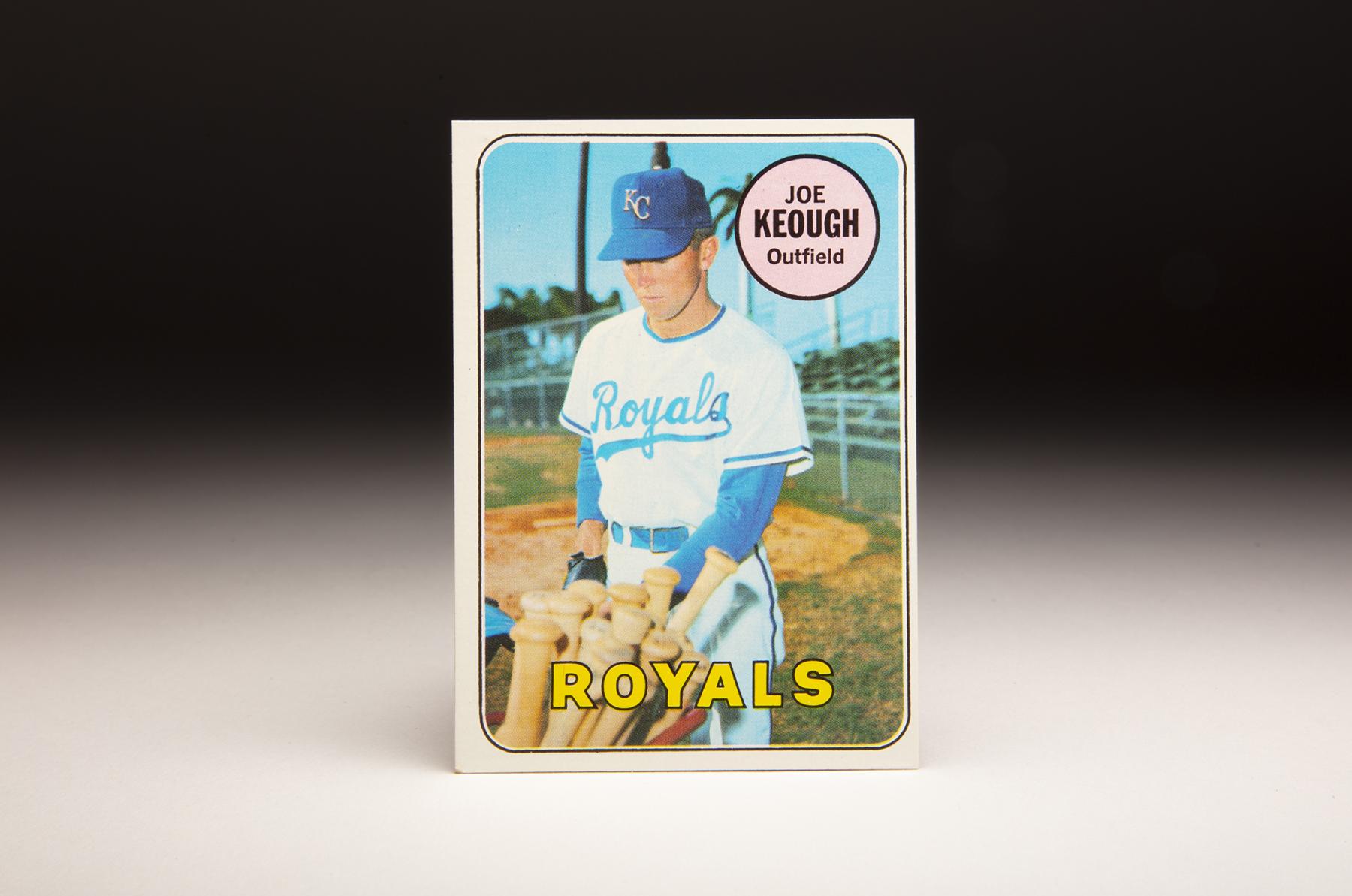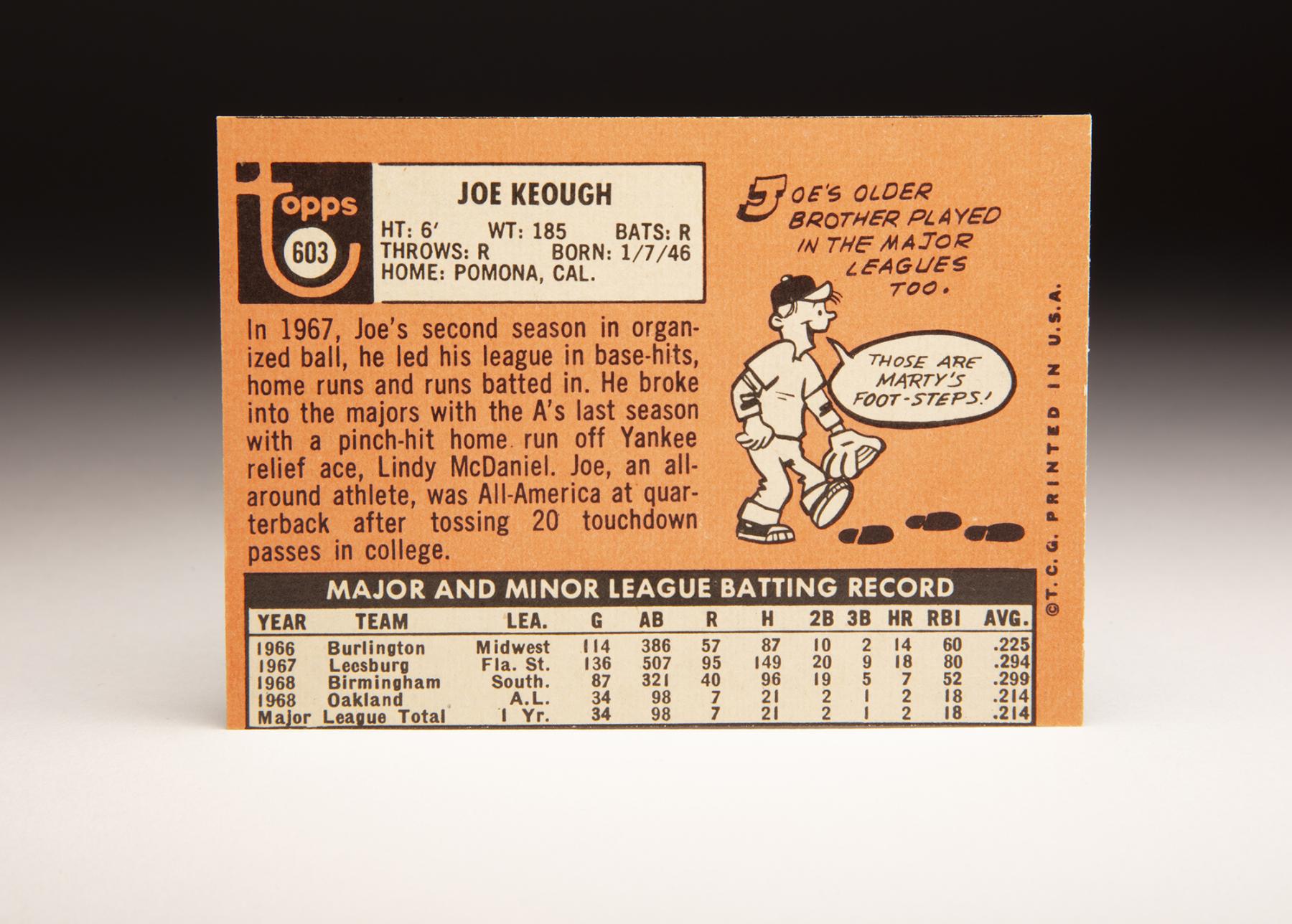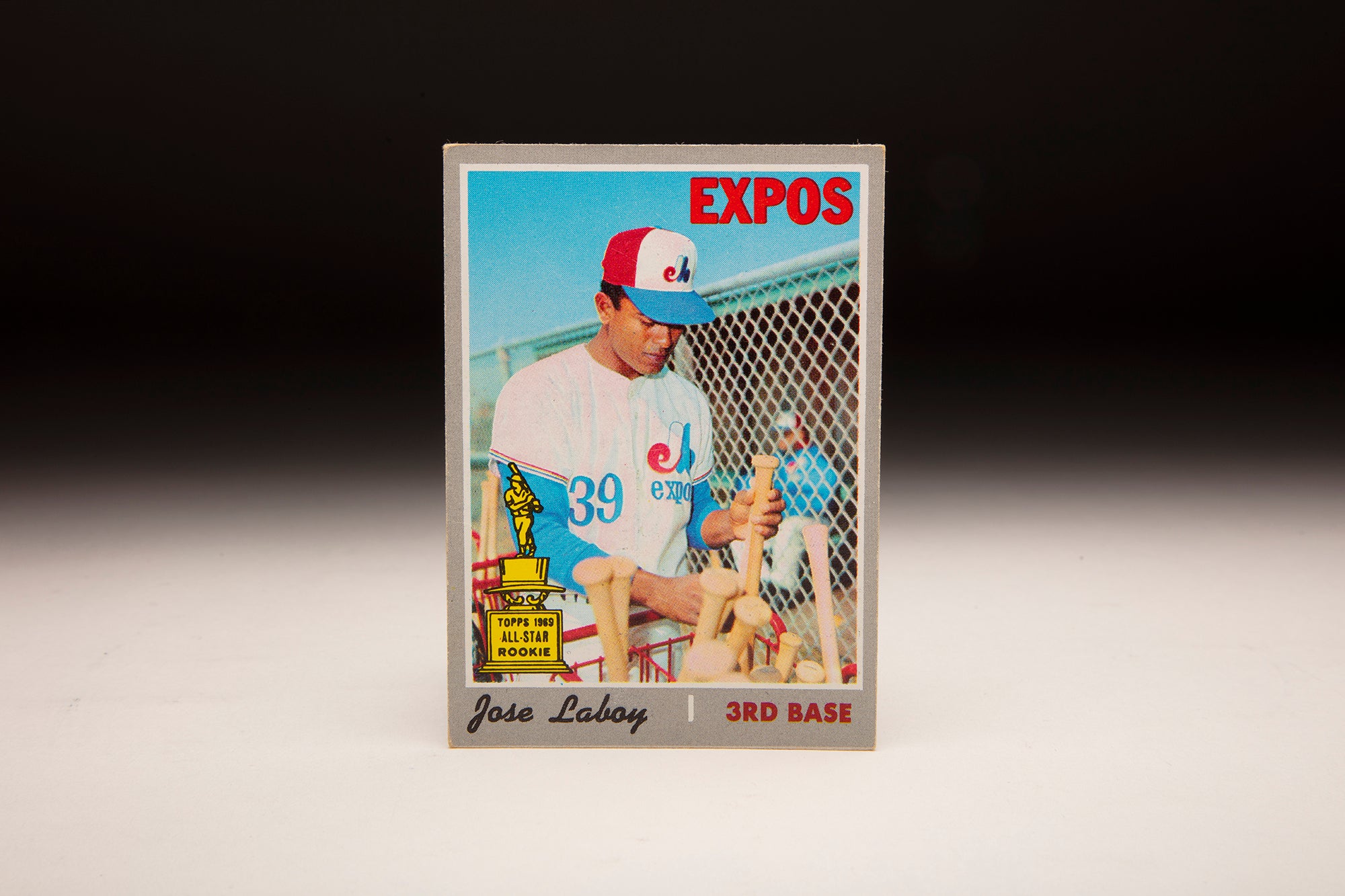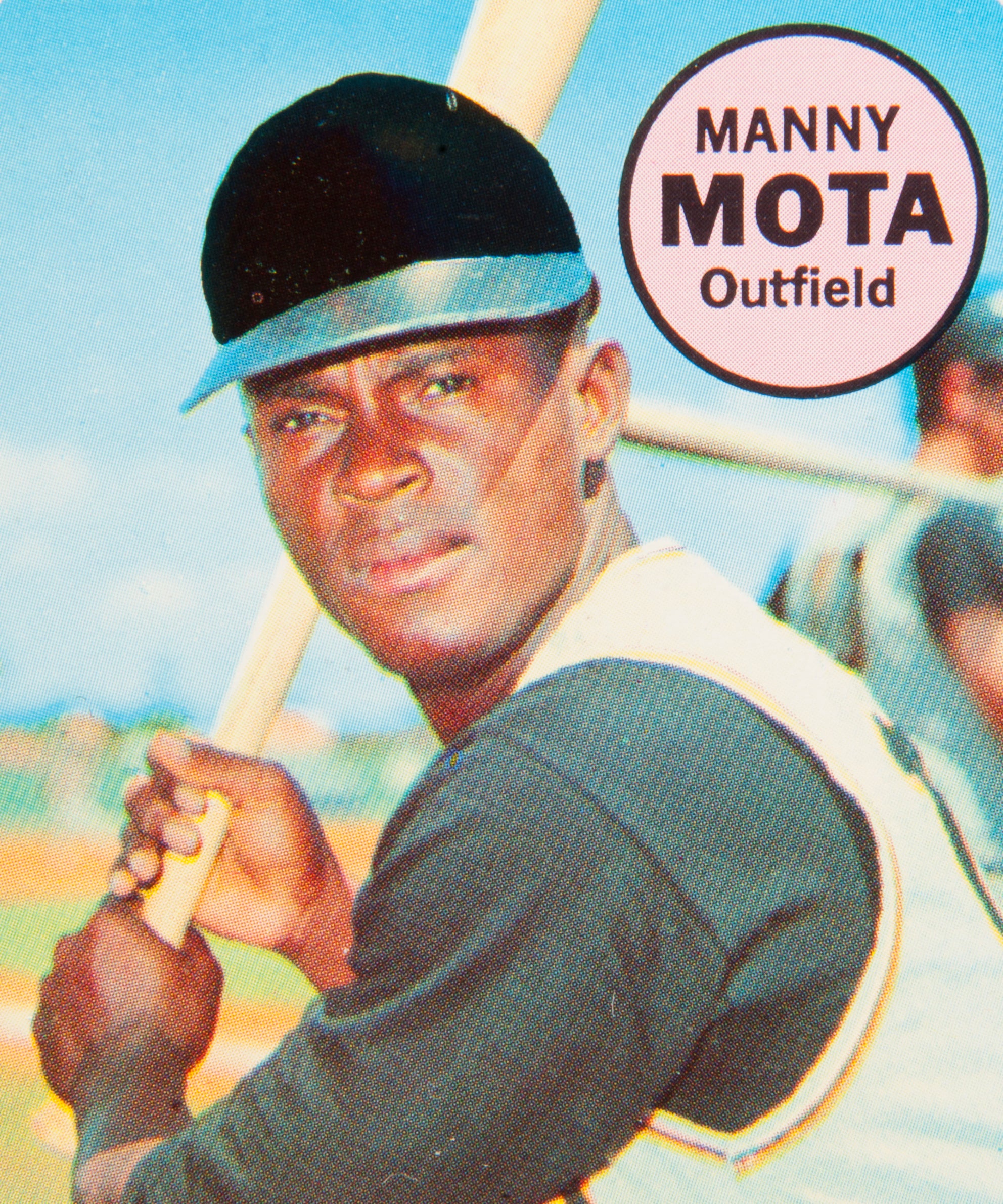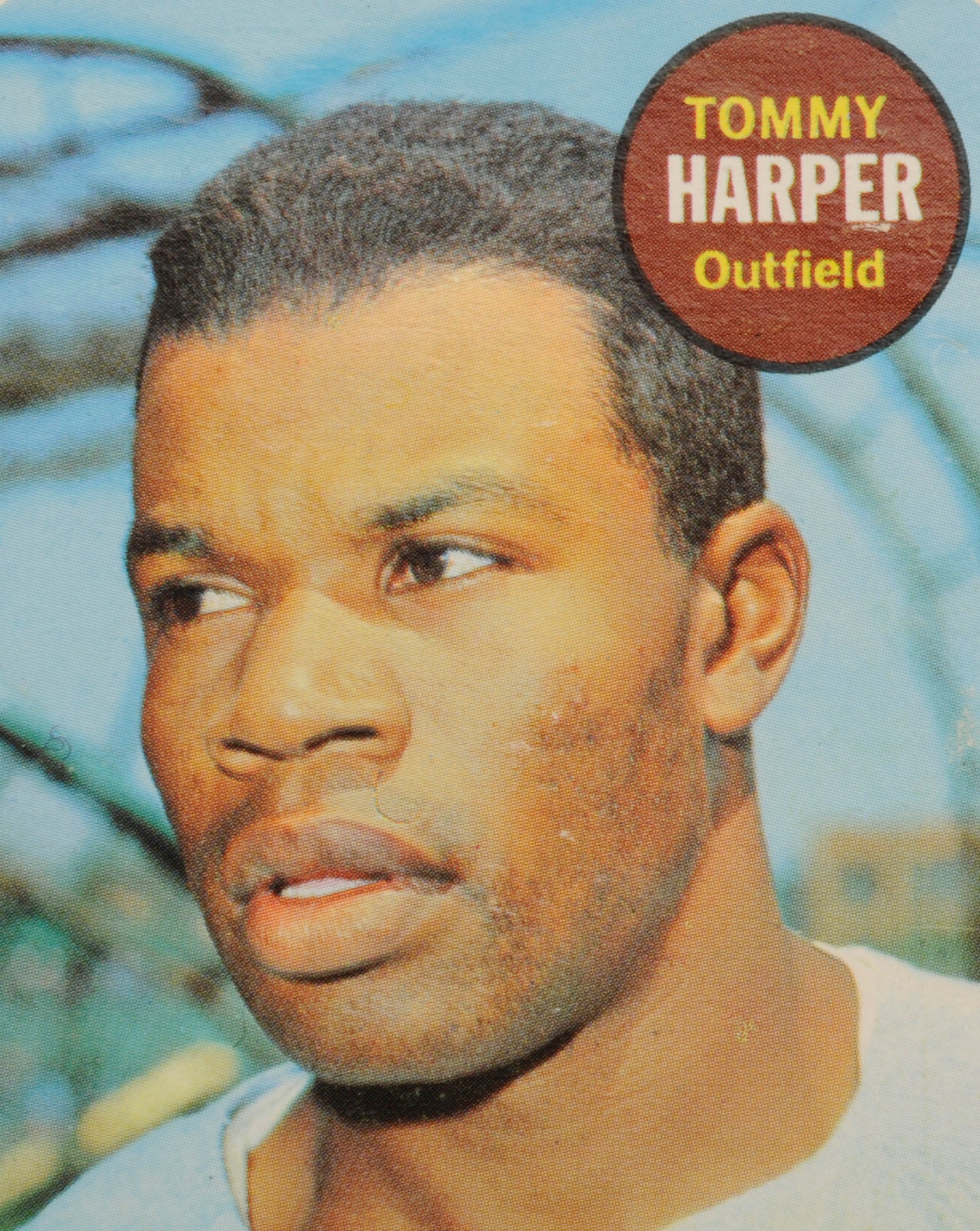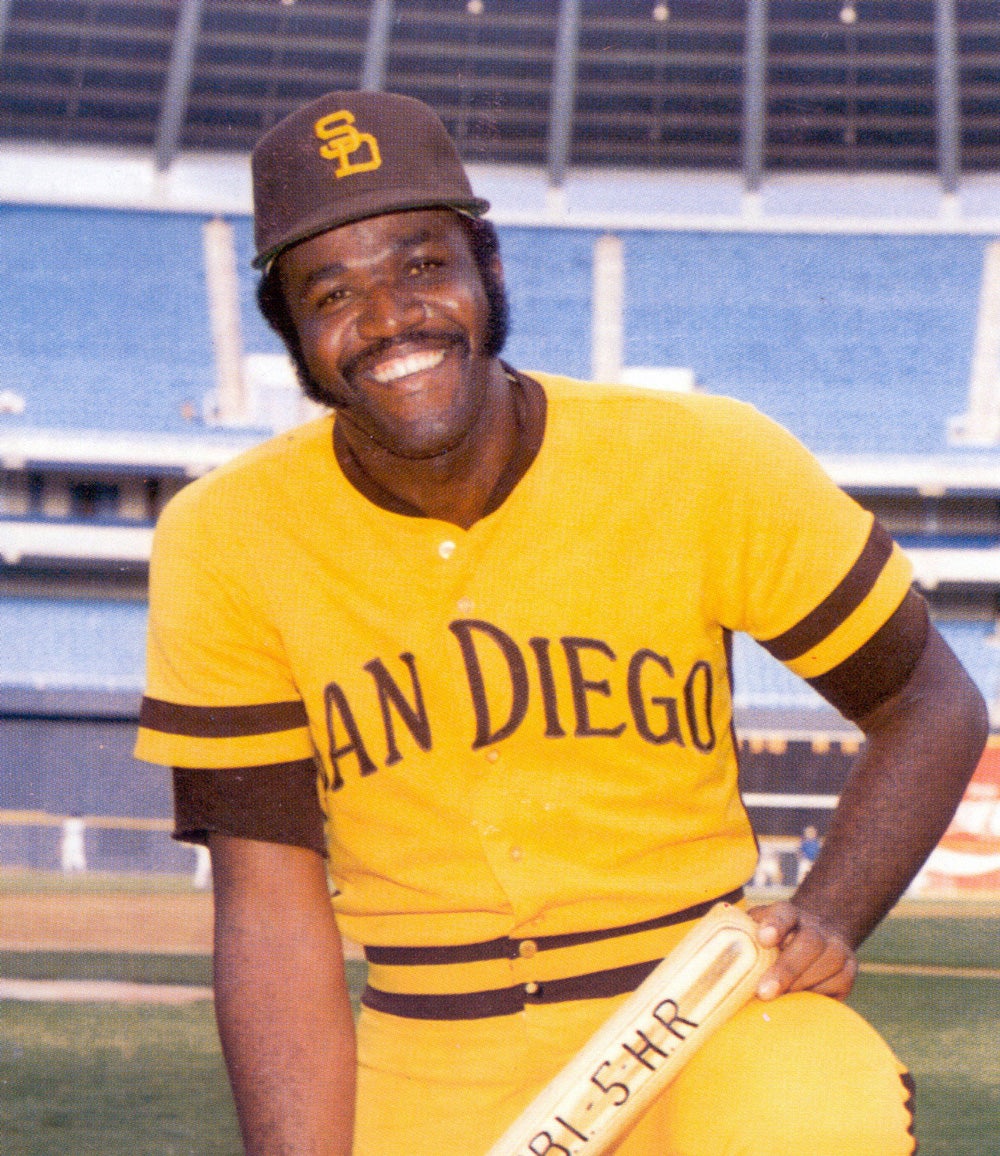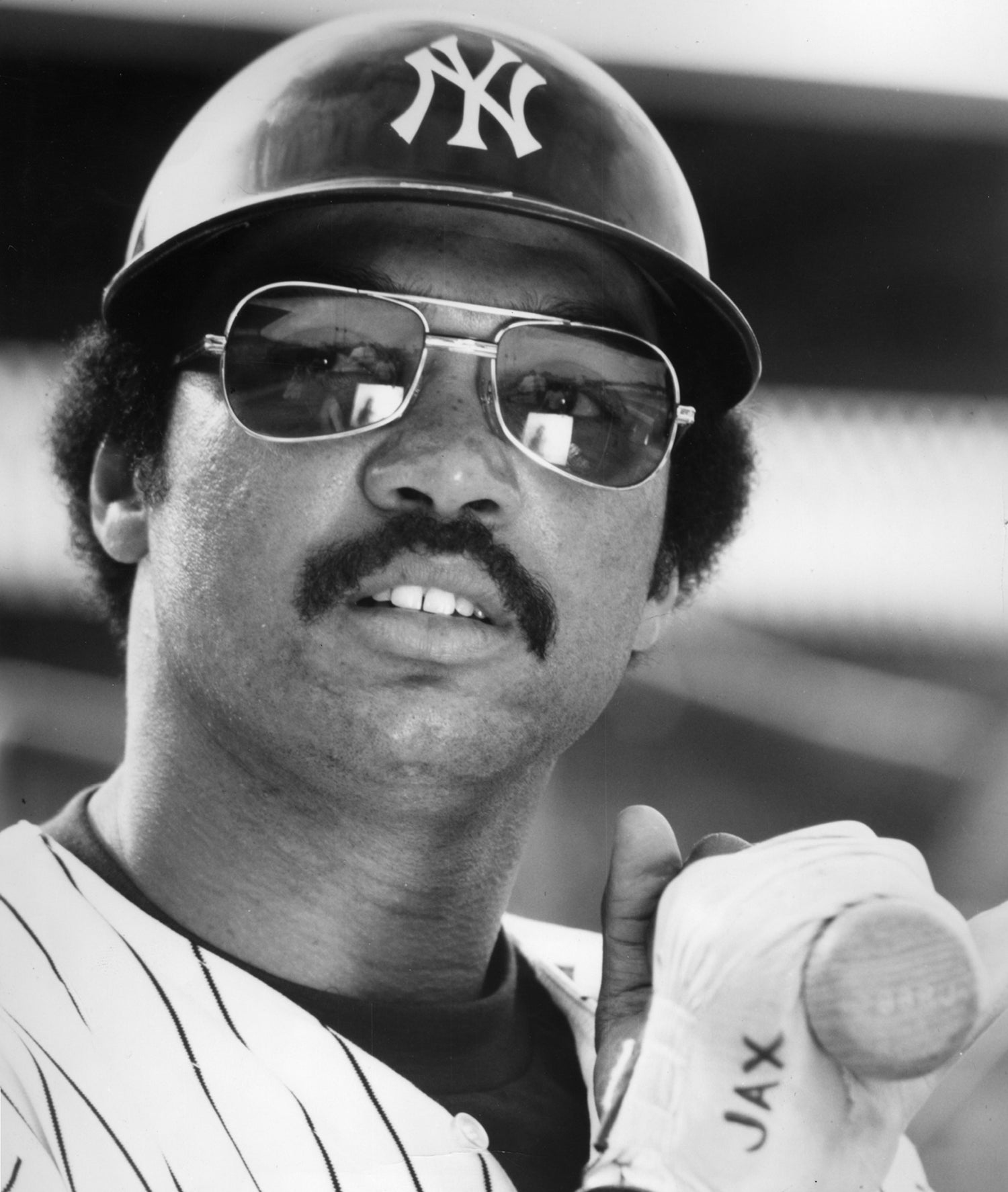- Home
- Our Stories
- #CardCorner: 1969 Topps Joe Keough
#CardCorner: 1969 Topps Joe Keough
Hall of Fame staffers are also baseball fans and love to share their stories. Here is a fan's perspective from Cooperstown.
From time to time in Card Corner, I’ve talked about some embarrassing attempts to pronounce players’ names during my youth.
Official Hall of Fame Apparel
Proceeds from online store purchases help support our mission to preserve baseball history. Thank you!
Hall of Fame Membership
There is no simpler, and more essential, way to demonstrate your support than to sign on as a Museum Member.
Growing up and attending school in Westchester County (not too far from the Bronx), my friends and I diligently collected each year’s new set of Topps baseball cards, but occasionally we’d come across a card from a few years earlier. Given the transient nature of baseball, it was fairly common to stumble upon a card of a player who was no longer in the game, often a player that we had never seen play. In some cases, the names remained familiar. In others, that was not the case. And when it came to a name that was out of the ordinary, we often butchered the pronunciation of the player’s name.
One such player was Joe Keough. Boy, we had trouble with that name. I thought it was pronounced KEE-uf. Someone else said that it should be pronounced KUFF. Another friend thought it was actually pronounced like the word “cough.” To a group of seven and eight-year-old boys, that made for a really funny name: “Joe Cough.”
Of course, all of our pronunciation guesses turned out to be wrong. Without the Internet at the time, we had no way of finding the right answer. (I suppose we could have asked our fathers, but that would have been too easy.) Eventually, many years later, we discovered that the proper way to say his last name is “KEY-oh.” Joe KEY-oh. It wasn’t as funny as Joe Cough, but it did rhyme at least. A cool name after all.
This discovery only came about because of the arrival of Joe’s nephew, Matt, in the major leagues. In the early 1980s, Matt Keough emerged as one of Billy Martin’s workhorse starters in Oakland. We often heard the pronunciation of Matt’s last name during TV broadcasts, and when the announcer mentioned that Matt was the nephew of Joe Keough, that gave us the answer that had eluded us for so many years.
All of this came back to memory because of the recent passing of Joe Keough, who died on Sept. 9 in Miami. Keough was 73 years old, and that was shocking to hear because he always looked so young on his baseball cards. Of the Topps cards that Keough appeared on during his relatively brief major league career, my favorite is the 1969 Topps card. He looks really young on that card, almost like a teenager, but in reality he was already 23.
Much like the Jose “Coco” Laboy card that was recently spotlighted in this space, Keough’s 1969 card shows him at the bat rack during the course of a sunny Florida day in Spring Training. Unlike a lot of the recycled images that were used in the 1969 set, this is a brand new photograph. After all, the Kansas City Royals were an expansion team that season; there were no old file photos of Keough wearing their uniform. No, this was a recent shot from the Royals’ first Spring Training camp in Ft. Myers, Fla. Numbered 603 in the set, the card came out much later during the summer, as part of Topps’ seventh and final series.
Keough was not a star, so he didn’t have any bats on special order from Hillerich and Bradsby; he just had to find a bat “off the rack,” to use the parlance of a department store. Whether this was a staged shot or not is anybody’s guess, but Keough is doing his best to make it look authentic. Notice that he is wearing a black batting glove on his right hand, indicating that perhaps he is about to take batting practice. With his head turned downward and the brim of his cap covering his eyes, Keough appears to be giving his choice of bats some serious consideration. Amidst that jumble of bats in that wooden box awaits the one bat that Keough is ready to make his own. Or maybe he’s just putting on a bit of a show for the Topps cameraman.
For Keough, it was his first appearance on a Topps card – coming out four years after he was drafted by the Kansas City Athletics. The A’s took Keough, the younger brother of former big league outfielder Marty Keough, out of Arizona State in the second round of the 1965 draft.
He signed late with Charlie Finley’s A’s, delaying his debut until the 1966 season. The A’s assigned him to Burlington of the Midwest League. The lefty-hitting outfielder showed good power (14 home runs), but batted only .225 in his first go-round against professional pitching.
Assigned to the Florida State League in 1967, Keough fared much better. He raised his average to .294, clubbed 18 home runs and showed plate discipline by drawing 67 walks against only 41 strikeouts. Given his good work in Class A ball, the A’s promoted him to Double-A Birmingham at the start of 1968. In 87 games, he showed only moderate power (seven home runs), but batted .299 with an OPS of .813. Defensively, he played the outfield extremely well, with above-average speed and a strong throwing arm.
With a young Joe Rudi struggling at the major league level, the A’s promoted Keough to Oakland, where they had relocated after the 1967 season. Called up in late summer, Keough made his debut on Aug. 7. In his very first at-bat, coming at the original Yankee Stadium, he faced New York right-hander Lindy McDaniel, the team’s fireman and best reliever. Keough promptly hit a home run, making him the 37th player in history to do so in his first big league at-bat.
“What do you think my reaction was?” Keough said to the Sporting News after the game. “All my idols played here. I was kind of star struck when I saw ‘The Mick’ [Mickey Mantle] here today.”
Unfortunately, the rest of the season in Oakland did not go well. Keough appeared in 34 games, and like Rudi he flailed against major league pitching. With a batting average of .214 and an OPS of .590, Keough seemed like he needed more preparation time in the minor leagues.
The A’s still liked the agile and athletic Keough as a prospect, but not as much as fellow young outfielders like Rudi, Rick Monday and Reggie Jackson. When it came time to compile a list of players to be protected from the upcoming expansion draft, the A’s left Keough off the list, meaning that he could be selected by either the Royals or the Seattle Pilots, the two newest American League franchises.
With the eighth pick overall, the Royals leapt at the opportunity to take Keough, with the anticipation that he would play a significant role in their inaugural season.
Keough made the Royals’ Opening Day roster, but he did not start the first game. In the 12th inning of the opener at Kansas City’s Municipal Stadium, Royals manager Joe Gordon called on Keough to pinch-hit for catcher Ellie Rodriguez. With the bases loaded and one man out, Keough stepped in against Twins right-hander Dick Woodson and delivered a clean single to right field, winning the game for the Royals. Just as he had done in Oakland, Keough had managed to create the best of first impressions in Kansas City.
Keough settled into a platoon role in right field, alternating with former Pittsburgh Pirates slugger Bob Oliver. But Oliver, Lou Piniella and Pat Kelly all hit better than Keough, rendering him to a backup role. By midseason, with his average bottoming out at .134, the Royals felt that Keough would be better served playing every day at Triple-A Omaha.
Spending most of June and half of July in the minor leagues, Keough batted over .300 at Triple-A and then returned to the Royals. He hit only slightly better in his second go-round with Kansas City, finishing the season with a .187 mark and no home runs.
Now at the crossroads of his career, Keough played well in the spring of 1970 and made the Royals’ roster. After starting the season on the bench, he moved into the starting lineup in May, the result of an injury to Piniella. Almost on cue, Keough proceeded to go on a hitting tear, raising his batting average to .337 by the end of the month. Keough credited his success to using a heavier bat and opening up his stance at the plate.
Keough continued to hit well through June 28, when a freak accident on the bases ruined his season. Keough was on second base when Amos Otis rapped a single.
Trying to score on the play, Keough slid into the plate, but his new pair of spikes caught on the corner of home plate, Keough heard a snapping sound, and looked down, where he saw that his right ankle had popped out of place.
The damages to Keough’s leg were massive. Keough not only dislocated his ankle, but broke his leg and suffered a detached ligament in his right knee. With immediate surgery required, Keough’s season came to a cruel end. Still, Keough did his best to maintain his perspective. “After going downstairs here [at the hospital], and seeing a couple of baseball fans who can’t even walk, you sure can’t feel sorry for yourself,” he told Kanas City sportswriter Joe McGuff.
During his stay in the hospital, Keough received more than 700 letters from fans, a tribute to his popularity in Kansas City. After his release from the hospital, he put his leg through rehabilitation successfully, allowing himself to report to Spring Training on time.
Whether it was because of the injury or other factors, Keough was never able to repeat the success of the first half of the 1970 season. He returned to the Royals as their right fielder in 1971, playing in a career-high 110 games, but batted only .248 with three home runs.
In 1972, Keough lost his starting job to Richie Scheinblum, an offseason acquisition from the Texas Rangers. Keough batted only .219 in a bench role, putting his future in Kansas City in jeopardy. The following February, just before the start of Spring Training, the Royals traded him to the Chicago White Sox for another lefty-swinging outfielder Jim Lyttle.
Keough started the 1973 season in Triple-A before being called up by the White Sox in July. They used him as a pinch-runner and pinch-hitter in five games before being sent back to the minor leagues. That October, the White Sox sold Keough to the Minnesota Twins, but he opted for retirement instead.
Choosing to leave baseball completely, Keough worked in marketing for several nationally known companies, including 7-Eleven and Burger King. His health remained good up until recently, but he passed away in September after a short illness.
While stardom eluded him in the major leagues, Keough managed to make it onto four Topps cards, which is four more than most of us. And by all accounts, he was a friendly guy, one who was well-liked by teammates and fans.
The man with the funny last name did well during his 73 years.
Bruce Markusen is the manager of digital and outreach learning at the National Baseball Hall of Fame and Museum

